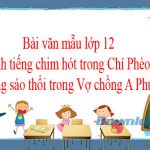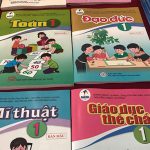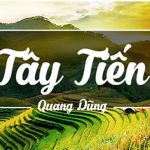Tiếng Anh 9 Unit 1: A Closer Look 1, Tiếng Anh 9 Unit 1 A Closer Look 1 được biên soạn bám sát theo nội dung SGK Tiếng Anh lớp 9 chương trình mới. Qua đó giúp học
Tiếng Anh 9 Unit 1 A Closer Look 1 giúp các em học sinh trả lời các câu hỏi tiếng Anh trang 8, 9 để chuẩn bị bài học trước khi đến lớp.
Soạn A Closer Look 1 lớp 9 được biên soạn bám sát theo nội dung SGK Tiếng Anh 8 chương trình mới. Qua đó giúp học sinh nhanh chóng nắm vững được kiến thức để học tốt tiếng Anh 9. Vậy sau đây là nội dung chi tiết, mời các bạn cùng theo dõi và tải tài liệu tại đây.
Xem Tắt
- 1 Tiếng Anh 9 Unit 1 A Closer Look 1
- 1.1 1. Write the verbs in the box under the pictures. One of them should be used twice.
- 1.2 2 a. Match the verbs in column A with the groups of nouns in column B.
- 1.3 3. What are some places of interest in your area? Complete the word web. One word can belong to more than one category.
- 1.4 4. Complete the passage by filling each blank with a suitable word from the box.
- 1.5 5 a. Listen to the speaker read the following sentences and answer the questions.
- 1.6 6 a, Underline the content words in the sentences. Practise reading the sentences aloud.
Tiếng Anh 9 Unit 1 A Closer Look 1
1. Write the verbs in the box under the pictures. One of them should be used twice.
Điền các động từ sau vào trong bảng. Một trong số chúng phải được dùng 2 lần.
A. cast (đúc)
B. carve (chạm khắc)
C. embroider (thêu)
D. weave (đan)
E. mould (khuôn)
F. weave (dệt)
G. knit (đan)
2 a. Match the verbs in column A with the groups of nouns in column B.
Nối các động từ ở cột A với danh từ ở cột B
1. f khắc chạm – đá, gỗ, vỏ trứng
2. d đúc – đồng, vàng, sắt
3. a đan, dệt – rổ, thảm, lụa, vải
4. c thêu – khăn tay, khăn trải bàn, tranh
5. b đan – áo len, đồ chơi, mũ
6. e khuôn – đất sét, phô mai, sô cô la
b. Now write the correct verb forms for these verbs. Viết lại dạng đúng của những động từ sau
| Infinitive | Past tense | Past participle |
| 1. to carve | I carved it | It was carved |
| 2. to cast | I casted it | It was casted |
| 3. to weave | I wove it | It was woven |
| 4. to embroider | I embroidered it | It was embroidered |
| 5. to knit | I knitted it | It was knitted |
| 6. to mould | I moulded it | It was moulded |
3. What are some places of interest in your area? Complete the word web. One word can belong to more than one category.
Địa điểm tham qua ở chỗ bạn là gì? Hoàn thành sơ đồ sau. Một từ có thể thuộc nhiều hơn 1 mục
Gợi ý:
– Entertaining: cinema, theatre, amusement park, department store, zoo, national park, …
– Cultural: pagoda, church, museum, craft village, historical building, ….
– Educational: library, museum, theatre…
– Historical: pagoda, temple, church, cathedral, market, tourist attractions, craft village…
4. Complete the passage by filling each blank with a suitable word from the box.
Hoàn thành đoạn văn bằng cách điền vào chỗ trống từ thích hợp trong bảng.
Some people say that a place of interest is a place famous for its scenery or a well-known (1) historical site. I don’t think it has to be so limited. In my opinion, a place of interest is simply one that people like going to.
In my town, the park is a(n) (2) attraction because many people love spending time there. Old people do (3) exercise and walk in the park. Children play games there while their parents sit and walk with each other. Another place of interest in my town is Hoa Binh market. It’s a(n) (4) traditional market with a lot of things to see. I love to go there because to buy food and clothes, and watch other people buying and selling. Foreign tourists also like the market because they can experience the (5) culture of Vietnamese people, and buy woven cloth and other (6) handicrafts as souvenirs.
Hướng dẫn dịch
Một số người nói rằng một điểm tham quan phải là một nơi có danh lam thắng cảnh hoặc di tích lịch sử nổi tiếng. Tôi không nghĩ điểm tham quan bị giới hạn như vậy. Theo ý kiến của tôi, một địa điểm tham quan đơn giản là một nơi mà mọi người thích đến.
Ở thị trấn của tôi, công viên là một điểm đến hấp dẫn bởi nhiều người thích dành thời gian để đến đó. Những người cao tuổi tập thể dục và đi bộ trong công viên. Trẻ con thì chơi các trò chơi ở đó trong khi cha mẹ ngồi nói chuyện với nhau. Một địa điểm tham quan khác trong thị trấn của tôi là chợ Hòa Bình. Đó là một chợ truyền thống với rất nhiều thứ để xem. Tôi rất thích đến đó để mua thức ăn và quần áo, và xem những người khác mua bán. Các khách du lịch nước ngoài cũng thích chợ này bởi họ có thể trải nghiệm văn hóa của người Việt Nam, và mua quần áo len cùng với nhiều đồ thủ công khác để làm quà lưu niệm.
5 a. Listen to the speaker read the following sentences and answer the questions.
Nghe người nói đọc những câu sau rồi trả lời câu hỏi.
Audio script:
The craft village lies on the river bank.
This painting is embroidered.
What is this region famous for?
Drums aren’t made in my village.
A famous artisan carved this table beautifully.
1. Which words are louder and clearer than the others? Từ nào được đọc to và rõ hơn những từ khác?
The craft village lies on the river bank.
This painting is embroidered.
What is this region famous for?
Drums aren’t made in my village.
A famous artisan carved this table beautifully.
2. What kinds of words are they? (Chúng là loại từ gì)
Noun (Danh từ), Adjective (tính từ), Adverb (trạng từ) and Verb (động từ), wh-question word (từ để hỏi)
3. Which words are not as loud and clear as the others?
(Những từ nào không được đọc to và rõ hơn những từ khác?)
The, on, in , this, my, for
4. What kinds of words are they? (Chúng là loại từ gì?)
Article (mạo từ), preposition (giới từ) and Possessive adjective (tính từ sở hữu), and wh-question words (từ để hỏi).
b. Now listen, check, and repeat Bây giờ hãy nghe, kiểm tra và nhắc lại.
In spoken English, the following kinds of words are usually stressed: main verbs, nouns, adjectives, adverbs, wh-question words, and negative auxiliaries (e.g. don’t).
Words such as pronouns, prepositions, articles, conjunctions, possessive adjectives, be (even if it is a main verb in the sentence), and auxiliary verbs are normally unstressed.
Hướng dẫn dịch:
Trong tiếng Anh nói, các từ sau đây thường được nhấn mạnh: động từ chính, danh từ, tính từ, phó từ, từ để hỏi ‘wh’, trợ động từ phủ định (ví dụ: don’t)
Các từ như: đại từ, giới từ, mạo từ, liên từ, tính từ sở hữu, tobe, (ngay cả khi nó là động từ chính trong câu), và trợ động từ thường không được nhấn mạnh.
6 a, Underline the content words in the sentences. Practise reading the sentences aloud.
Gạch dưới những từ nội dung trong các câu. Thực hành đọc to các câu.
1. The Art Museum is a popular place of interest in my city.
2. This cinema attracts lots of youngsters
3. The artisans mould clay to make traditional pots.
4. Where do you like going at weekend?
5. We shouldn’t destroy historical buildings.
b. Now listen, check and repeat. Bây giờ nghe, kiểm tra và nhắc lại.










